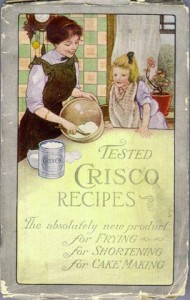In the late 1830’s, two men were involved in different businesses.
William was a candle maker from England and became well established in Cincinnati, Ohio. James, on the other hand, relocated from Ireland and apprenticed himself to a soap maker in that same town. Strangers in a new land, they might never have met.
But …
Fate struck a blow that brought these two men together to form a single company. They married sisters Olivia and Elizabeth Norris, daughters of Alexander Norris. The father-in-law convinced the young men to become business partners, forming a bold new enterprise.
They would be competing with 14 other soap and candle businesses in Cincinnati.
Things quickly got interesting. The two business partners also entered the shortening industry. At the time, soap and candles had common ingredients: lard and tallow. But the meat packing monopoly controlled the price of both. However, they found that cottonseed oil could be used to make all three products, so they purchased eight cottonseed mills.
Then, a scientific discovery and a technological threat created a legacy product.
A Wizard and Hydrogenation
Thomas Alva Edison, oft referred to as the Wizard of Menlo Park, was bringing electricity to homes across America. And with it came a very real threat to William’s candle making side of the business. Candles had been the main source of home illumination for a very long time.
The electric light bulb could snuff that out in short order.
About the same time, the two men discovered that cottonseed oil could be solidified. With the help of German chemist E.C. Keyser, they soon developed a process that turned the oil into a solid form that resembled lard. A shortening that wouldn’t melt at room temperature.
Hark! A new product that could be used for cooking.
William Proctor and James Gamble presented this new product to the American public in 1911. Its name: Crisco®. Proctor & Gamble set off on an ingenious marketing plan to bring their product front and center to the American home and kitchen.
And even though the Internet wasn’t even a glimmer in anyone’s monacle, content marketing was the key.
A Stroke of Content Genius

Now, I’m not going to delve into the merits of the product.
But, I am astounded at the marketing genius of the two businessmen.
In 1912, they produced a cookbook called “Tested Crisco Recipes,” that not only explained how the product was developed and made, but also presented hundreds of recipes using the product.
P&G gave away copies of the cookbook with the product. And they mailed free copies all across America to anyone who requested. The consumer merely had to send them five 2-cent stamps.
The new product could be used for everything from frying fish to baking … cupcakes.
The Power of “How You Use It”
What made this campaign so successful? Why did it work?
I believe the answer lies in the Proctor & Gamble boys using content marketing as an effective tool. Sure, they provided the public detailed information about the features – how and why the product was developed and what it could do. Many of their ads read like scientific papers.
They pulled back the curtain on the process, showing exactly what went on behind the scenes in the factory. “Pure Food from a Clean Factory,” touted one ad.
And yes, they touted the benefits of the product. Using scientists and other experts, they went beyond mere features and explained the benefits of those features.
They kept asking the all-important question, “Ok, that’s a good feature … but so what?” They answered each feature with a corresponding benefit.
But, the “pièce de résistance” was educating the consumer in how to use it.
Homemakers wanted to provide healthy, delicious foods to their families. So they developed the cookbook, with hundreds of recipes using Crisco®.
They hired “home economists” to teach homemakers how to use the product. In doing that, they also helped support the relatively new field of Home Economics. They paid celebrity chefs to teach cooking classes using the Crisco® product, lending it credibility.
They employed all four aspects of content marketing:
- Building awareness
- Showcasing the features
- Explaining the benefits, and
- Teaching their prospects and customers how to use the product.
Content Marketing Educates Your Prospect
If you’re like me, you’ve looked at a product or service and said to yourself, “Looks good. Great features. And I understand the benefit; but … I just don’t see how that would work for me. I don’t see the need to change. Besides, I don’t know if I can even implement it.”
I believe that William and James understood that. Lard was the shortening of choice in that era. So they not only needed to educate their market in the features and benefits, but in how to use it as well.
It’s still necessary today.
Many products are so similar to their competitors (yet unique in some aspect) that education in using them is all that sets them apart. The education can be done in several ways. But rich media is often the most effective.
For example, I write marketing content for a light pole manufacturer in Australia.
Exciting, right? You’d be surprised.
It’s a light pole with a twist, or more accurately, a swivel. And unlike most light poles, it solves a wide range of problems in the lighting maintenance field.
Not only does it promote safe work practices, but it addresses ergonomic issues as well. And for routine maintenance, the cost savings are incredible when using their system.
While you can write about it all day long, brief videos show how it can be applied, both as new installations and as retrofits to existing poles. Using both real videos and animations, they show their targeted market why they should use it and how they can use it.
Create Your Own Content Marketing Recipe
When William and James formulated their marketing plan, it was a recipe for success. It transformed them from simple candle and soap makers into giants in the food preparation and household products markets.
Their business grew beyond the borders of Cincinnati and propagated nationwide … and beyond.
Are you ready to do the same?
On your next product launch (or relaunch of a revised, upgraded product or service), formulate a strategy for content marketing success.
Describe the features. Promote the benefits. But don’t forget to educate your targeted market in how to use it. Blend it in with all the many marketing ingredients.
If you have a Key Message Copy Platform, it should have a reserved space in it. (If you’re not sure what that is, call me.) By including consumer education, they’ll devour your product … and maybe ask for more.
Wishing you the very best of success in your content marketing recipe!
__________________________________
Article written by Steve Maurer – Steve Maurer Freelance Writing
You can email me at steve@maurer-copywriting.com or call me at +1 (479) 304-1086
Mailing address:
Steve Maurer
3000 West Anne Street
Fayetteville, AR (Arkansas) 72704
United States of America
Cupcakes photo taken by Stacie Merriman. Delicious looking, aren’t they!

Great info and well written. Thanks!